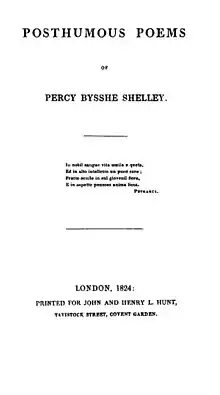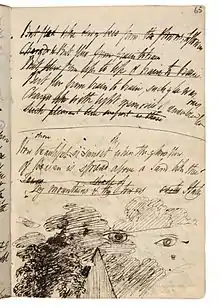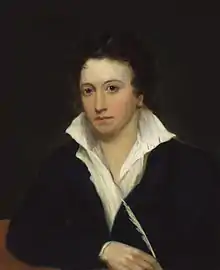| "Julian and Maddalo: A Conversation" | |
|---|---|
| Short story by Percy Bysshe Shelley | |
 Posthumous Poems of Percy Bysshe Shelley | |
| Country | United Kingdom |
| Language | English |
| Genre(s) | Philosophical poem, dialogue |
| Publication | |
| Published in | Percy Bysshe Shelley Posthumous Poems |
| Publisher | John and Henry L. Hunt |
| Media type | Print (hardback) |
| Publication date | 1824 |
Julian and Maddalo: A Conversation (1818–19) is a poem in 617 lines of enjambed heroic couplets by Percy Bysshe Shelley published posthumously in 1824.
Background
This work was penned in the autumn of 1818 at a villa called I Capuccini, in Este, near Venice, which had been lent to Shelley by his friend Lord Byron, and it was given its final revision in 1819. Shelley originally intended the poem to appear in The Examiner, a Radical paper edited by Leigh Hunt, but then decided instead on anonymous publication by Charles Ollier. This plan fell through, and Julian and Maddalo first appeared after Shelley's death in a volume of his works called Posthumous Poems in 1824 (see 1824 in poetry), edited by his widow Mary Shelley.[1] It is inspired by conversations Shelley had with Byron in Venice in 1818, in which they explored their different outlooks on life. The bitter cynicism of Count Maddalo in the poem reflects closely Lord Byron's views, as Julian's atheism and faith in the potentialities of man does those of Shelley himself. It is written in a conversational, natural style, which had not until then been usual in Shelley's works, and which may have been partly suggested by Byron's poem Beppo. Julian and Maddalo was in its turn a strong influence on the dramatic monologues of Robert Browning.[2]
Synopsis

"Julian and Maddalo" is prefaced by a prose description of the main characters. Maddalo is described as a rich Venetian nobleman whose "passions and…powers are incomparably greater than those of other men; and, instead of the latter having been employed in curbing the former, they have mutually lent each other strength"; while Julian is said to be
an Englishman of good family, passionately attached to those philosophical notions which assert the power of man over his own mind, and the immense improvements of which, by the extinction of certain moral superstitions, human society may be yet susceptible…He is a complete infidel, and a scoffer at all things reputed holy.[3]
The poem proper then begins with a depiction of the two title characters riding through a Venetian scene and discussing the subjects of religious faith, free will and progress. Julian
Argued against despondency, but pride
Made my companion take the darker side.
The sense that he was greater than his kind
Had struck, methinks, his eagle spirit blind
By gazing on its own exceeding light.[4]
They then board the Count's gondola and pass a lunatic asylum, which provokes from Maddalo a comparison between the inmates' situation and the futility of all mortal life. The next day Julian visits Maddalo and meets his baby daughter (based on Byron's daughter Allegra),[5] whose childish innocence inspires him to a statement of his own optimistic belief in the power of Good. Maddalo dismisses Julian's creed as utopian, and compares him with a former friend who has since gone mad known as the Maniac. They again take the gondola to the madhouse to meet this man, the Maniac, who tells them a confused and disconnected account of an ill-fated romance and of his abandonment by his lover. (This character has been identified by scholars as a composite of Shelley himself and the poet Tasso; the lover perhaps as Mary Shelley, whose relationship with the poet had lately been under some strain.)[6] Julian and Maddalo are downcast by the Maniac's story, Maddalo commenting that
Most wretched men
Are cradled into poetry by wrong,
They learn in suffering what they teach in song.[7]
Julian leaves Venice but, returning many years later, asks Maddalo's daughter about the madman or the Maniac and is told that his lover had returned and again left him, and that both were now dead.
Notes
- ↑ George Saintsbury A History of English Prosody: From the Twelfth Century to the Present Day (London: Macmillan, 1923) vol. 3, p. 108; Thomas Hutchinson (ed.) The Complete Poetical Works of Shelley (Oxford: Clarendon Press, 1904) pp. 204, 219–220.
- ↑ Sir A. W. Ward and A. R. Waller (eds.) The Cambridge History of English Literature (Cambridge: Cambridge University Press, 1915) vol. 12, p. 63; "Julian and Maddalo: A Conversation". The Oxford Companion to English Literature. Edited by Dinah Birch. Oxford University Press Inc. Oxford Reference Online. Oxford University Press. West Sussex County Library Service. 24 December 2009 <http://www.oxfordreference.com/views/ENTRY.html?subview=Main&entry=t113.e4098>
- ↑ Preface
- ↑ Line 48
- ↑ "Julian and Maddalo: A Conversation". The Oxford Companion to English Literature. Edited by Dinah Birch. Oxford University Press Inc. Oxford Reference Online. Oxford University Press. West Sussex County Library Service. 24 December 2009 <http://www.oxfordreference.com/views/ENTRY.html?subview=Main&entry=t113.e4098>
- ↑ "Julian and Maddalo: A Conversation". The Oxford Companion to English Literature. Edited by Dinah Birch. Oxford University Press Inc. Oxford Reference Online. Oxford University Press. West Sussex County Library Service. 24 December 2009 <http://www.oxfordreference.com/views/ENTRY.html?subview=Main&entry=t113.e4098>; H. C. G. Matthew and Brian Harrison (eds.) The Oxford Dictionary of National Biography (Oxford: Oxford University Press, 2004) vol. 50, p. 207.
- ↑ Line 544.
